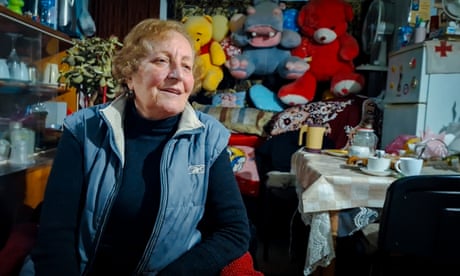
The three blocks of flats which step up a Tbilisi hill, linked by a metal bridge, are a concrete reminder of Georgia’s Soviet past.
The state-owned Nutsubidze apartments and their skybridge opened in 1978, the 140 flats distributed to blue- and white-collar workers as part of a USSR effort to expand urban housing in its territories.
In a one-room apartment behind a lift shaft, 70-year-old Mzia Sabanadze continues an almost extinct occupation, manually operating one of the lifts at Nutsubidze. The pay-to-ride elevator she operates – the only one of the four in the blocks open to non-residents – is for those living in the flats, local people taking a shortcut to the top of the hill, and tourists who come to see this monument to brutalist architecture.
Sabanadze, a soldier who fought in the 1992 separatist Abkhazia war for the Georgian government side, has been working at the building for 18 years, supplementing her veterans’ pension of 300 lari (£90). She first ran the elevators with her husband until he died seven years ago. After his death, a shift man took over his position until he too died in 2020. Since then, Sabanadze has been alone, apart from her two cats Nia and Mia, living in a crumbling one-room flat decorated with a portrait of Joseph Stalin.
Her role is to continuously monitor the CCTV cameras by the elevators and the audio transmitter that channels the sound of a coin tossed in the box, signalling her to flip a switch that takes the elevator up or down. She has a microphone in her room that lets her speak directly into the cabin.
“I’m always here, greeting everyone, respecting everyone and seeing everyone out,” she says.
At night she leaves the radio transmitter on as she goes to sleep. On the rare occasions when someone needs to use the lift during the night, she wakes up to the sound of the tossed-in coin and presses the button to start it.
“No matter how deep I sleep, as soon as I hear a rustle [from the transmitter], I open my eyes,” she says.
The picture of Stalin, who represents a nostalgic period of pride in Georgia’s role within the Soviet Union despite his divisive legacy, sits among the religious memorabilia and a pile of teddy bears for her visiting grandchildren that decorate her room.
“What is 300 lari?” she says of her meagre income. “I haven’t left my flat in three years. Sometimes the tourists come and bring me some food or leave some money. They [the government] put everything in their pockets. What can I do? At least I have a job.”
The Nutsubidze blocks and skybridge were designed by Georgian architects Otar Kalandarishvili and Gizo Potskhishvili. To ease the difficulties of the hillside location, the architects designed the skybridge – metal walkways linking the blocks – taking inspiration from Georgia’s historic village, Shatili, with its houses connected by bridges, says Sabanadze. Each floor has three flats: four-room, three-room and one-room, although over time some of the bigger flats have been divided into two.
Sabanadze says many people have lived here since the Nutsubidze opened, many generations of families.
“During winter, no transport goes up or down the hill when there’s snow or ice, and these three buildings, with the bridge passing through, were built because this road is good, easy, convenient and fast,” she says.
The architects originally envisioned Nutsubidze as a part of a larger project: a skybridge network connecting entire neighbourhoods and solving the landscape challenges of the plateau district. Funding constraints shattered the ambitious plans, leaving only these three connected blocks as a testament of what was to be an international example of great urban planning. They still serve the wider community, as non-residents can use the bridges through Sabanadze’s elevator to easily access a different part of the district on top of the plateau.
The three other elevators across the building are automatically summoned for use by people who live in the flats who can use the money on their residency cards to access any floor for 10 tetri (3p) a ride. The stairs are also reserved for residents.
Non-residents and tourists can each toss a 20 tetri coin into the box of the elevator monitored by Sabanadze in the first block, which takes them directly to the skybridge on the 14th floor.
Many of the Soviet-era buildings and infrastructure are being claimed by time and disrepair in Tbilisi, becoming part of the ageing landscape of a city bedevilled by neglect. Many of them were turned into refugee camps during the Abkhazia conflict and Russo-Georgian war, including the Iveria hotel, also designedby Otar Kalandarishvili.
For Sabanadze, remembering the old days is tinged with sadness.
“With these hands, how many lives I gave [birth to], how many eyes I closed, buried,” she says, referring to her four sons, 12 grandchildren and two great-grandchildren still living; and to her husband and all the family and friends she has lost throughout her life, especially during the 1992-1993 Abkhazia war, one of the many conflicts stemming from ethnic and territorial disputes aggravated by the dissolution of the Soviet Union.
But, as the CCTV shows a group of young tourists approaching, she is on her feet, ready to offer her assistance.